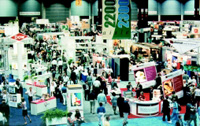How Exhibitors Can Get the Most Out of Trade Shows
BUSINESS/MARKETING
Trade shows such as IFT’s Food Expo are valuable not only to those attending but certainly also to those exhibiting.

With Food Expo just weeks away, here’s a checklist I compiled—with a little help from trade show expert Allen Konopacki, president of the INCOMM Center for Research and Sales Training, and Ted Tate, head of Tate & Associates—to help exhibitors get the most out of their time and money:
• Establish a Clear Mission. Trade shows have a life span roughly equivalent to that of a mayfly, so the show floor is no place to begin to coordinate staff and assignments. Goals and objectives should be quantifiable and measurable. Exhibit staffing should be based on selecting the people best qualified to achieve the mission. The target audience should be determined in advance.
• Establish Measurable Goals. Are you there to sell, meet customers, build or introduce your brand, conduct market research? In any case, go into a trade show with specific numbers for expected sales prospects, dollar sales, or closed business.
• Conduct Pre-show Team Meetings. Team meetings before the show should clearly communicate mission, goals, and specific tactics, such as how to engage people, establish individual goals, when break times occur, and booth policies. Describe the target audience to all personnel to minimize wasted time and effort and maximize results. Duty rosters are a good idea, even for the smallest booth.
• Pre-Plan Printed Materials Around a Strategy. Expensive color brochures often have little additional impact over a crisp, one-page fact sheet. Concise information also is far more helpful to serious potential clients who may ship back 30 lb of printed information. Put a writer in charge who understands the mission and goals. Consider pre-show mailings as a way to increase traffic at the show. About a third of exhibit visitors are influenced by the promotions, according to Konopacki.
• Design a Visitor-Friendly Booth. Unless your goal is to have a private country club for your best customers, booth design should be open and inviting. Remove barriers and create areas for discussion. The cafes and sampling centers used by many IFT exhibitors are excellent examples. But once you’ve got the people, your exhibit staff must know what to do with them.
• Generate Meaningful Customer Information. “To boost your followup impact, obtain the names of people with whom booth visitors will share information, such as supervisors and colleagues,” Tate says. Drawings and demonstrations also work to collect customer data.
• Establish a Lead Followup System Before the Show. “Booth staffers need to have a set of questions readily available to help identify potential customers. Have a way to follow up any really serious leads immediately,” Tate stresses. He also discourages novelties that don’t support the mission. Most of them wind up in a desk drawer or in the hands of kids. If you glean proper contact information at the show, a followup mailing can provide more costly printed information that will have a greater chance of being read and used. More-expensive novelties in more-limited numbers can be used for drawings and prizes.
• Train Your Booth Personnel. The experts advise the following: No eating in the booth—it’s okay for the customer, not the staffer. No sitting, unless you’re engaging a customer in a sales discussion. Off-duty personnel should not hang out at the booth, everyone on duty should be focused on the mission. No chitchat among booth personnel. Avoid standing behind tables, unless you’re a server. Personnel should be out front, engaging people—and they should know how to do it. Questions and greetings should be rehearsed. This will help predetermine serious leads.
• Dress Right. Experts vary in opinion here, because of the diverse nature of individual shows. Generally, suits are considered too formal and polo’s too informal. Embroidered long-sleeve casual shirts represent the middle road. However, this can vary depending on your mission. In any case, attire should be an integral part of your overall plan.
• Sustain the Effort. Some of your best leads may come late in the day. Booth personnel should be as fresh at the end of the show as when the opening bell sounds. In addition, make sure you’re fresh in the morning—late nights with clients don’t mix well with early start times.
• Develop Cross-Cultural Sensitivity. Food Expo, like most large international expositions today, draws a global audience. Attendees from Europe, Latin America, Asia, and Down Under travel long distances and incur considerable cost to attend. Many may represent your best prospects; so make sure booth personnel are trained to be sensitive to their unique speech patterns and expectations.
• Recycle. Finally, a suggestion from Christine Ellis, a trade show marketing consultant. She urges her clients to donate leftover giveaways and printed materials to local charities serving children. They use the materials for crafts and other activities. In addition, leftover food can be donated to such organizations as Second Harvest, an activity that has been promoted by IFT for a number of years.
Trade shows are an expensive proposition. Don’t take any detail for granted.
by PIERCE HOLLINGSWORTH
Contributing Editor
